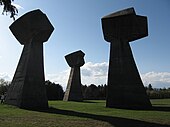Bubanj Memorial Park: Difference between revisions
→World War II: massage the English |
→Federal Republic of Yugoslavia: English fixes |
||
| Line 21: | Line 21: | ||
=== Federal Republic of Yugoslavia === |
=== Federal Republic of Yugoslavia === |
||
In [[1950]], the execution site was originally marked by a memorial pyramid. A new monument, "Three fists", was commissioned by Croatian sculptor [[Ivan Sabolić]] and was unveiled on [[14 October]] [[1963]].<ref>[http://www.nistourism.org.rs/bubanj.html Bubanj at wwww.nistourism.org.rs] {{sr icon}}</ref> |
|||
Bubanj Memorial Park was declared [[Historic Landmarks of Exceptional Importance (Serbia)|Historic Landmark of Exceptional Importance]] in 1979, and it is protected by [[Republic of Serbia]].<ref name="SANU"/> |
Bubanj Memorial Park was declared a [[Historic Landmarks of Exceptional Importance (Serbia)|Historic Landmark of Exceptional Importance]] in 1979, and it is protected by the [[Republic of Serbia]].<ref name="SANU"/> |
||
=== Recent History === |
=== Recent History === |
||
Revision as of 14:28, 16 July 2010

Memorial Park Bubanj (Serbian: Мемориjални парк Бубањ) is a World War II memorial complex built to commemorate the shooting and execution of the 10,000 citizens of Niš, and it is located in Palilula municipality of Niš, Serbia.
Standort
Situated on the hill southwest of the Bubanj of Niš, which cut the main road Niš - Skopje, is situated 2 km from the other Serbian Cultural Property of Great Importance, Crveni Krst concentration camp.
Memorial complex

The complex is arranged as a park, with a memorial trail about half a mile long running through it. The centrepiece of the site is a marble relief measuring 23 by 2.5 metres, with five compositions that symbolize the "killing machine": execution and firing squads, civil revolts, surrender of the German invaders and final victory over the oppressors.
Another dominant feature of the park is three concrete obelisks that symbolize raised hands with clenched fists.[1] Each of the three fists are different sizes, depicting men's, women's and children's hands that defy the enemy, symbolic of the fact entire families were killed at Bubanj.
Nearby there is a summer stage.
History
World War II
German execution squads established sites in Bubanj forest to which Serbs, Gypsies and Jews were brought by trucks. Mass exterminations were carried out from February 1942 to September 1944, [2] including about 10,000 inmates and detainees killed by the Special Police and local penal authorities. The entire area is intersected by trenches in which the shooting victims were buried. Before the withdrawal of the Germans as the Red Army advanced into Yugoslavia in 1944, captured Italians were ordered to dig up the trenches and burn the corpses of the victims in order to destroy all traces of the atrocities committed there.[2]
Federal Republic of Yugoslavia
In 1950, the execution site was originally marked by a memorial pyramid. A new monument, "Three fists", was commissioned by Croatian sculptor Ivan Sabolić and was unveiled on 14 October 1963.[3] Bubanj Memorial Park was declared a Historic Landmark of Exceptional Importance in 1979, and it is protected by the Republic of Serbia.[1]
Recent History
In 2004 in the complex the chapel was built of glass and metal. It is architectural work of the architect Alexander Buđevac, and on 2009, big reconstruction project occurred on entire Bubanj memorial hill.[4]
Gallery
-
Entrance on Bubanj hill
-
Path to the monument
-
Overview of the memorial front view
-
Death row
-
Summer stage
-
Bubanj Glass chapel
See also
References
External links
- Cultural Monuments in Serbia
- Palilula and Culture: Historical monuments ((en))
- Bubanj at wwww.nistourism.org.rs Template:Sr icon
- СПОМЕН ПАРК „БУБАЊ“ НА МЕТИ ВАНДАЛА Template:Sr icon






